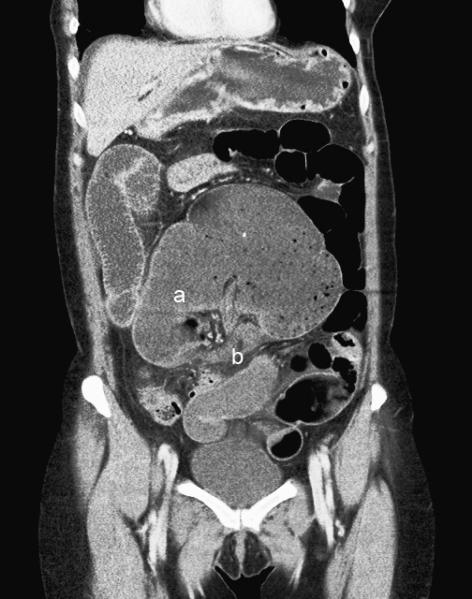Introduction
Appendiceal mucocele can present in various ways but is most commonly encountered incidentally during appendectomy. [1] We report a case of large bowel obstruction presenting as a closed loop with an appendiceal mucocele as the lead point superimposed on a chronic ileal stricture that had been misdiagnosed as irritable bowel syndrome.
Case Report
A 51 year old woman presented to the emergency room after four days of nausea, vomiting, obstipation and lower abdominal pain. She had experienced chronic severe intermittent abdominal pain and bloating for several years and had been diagnosed with irritable bowel disease. In the past, she had undergone cholecystectomy, hysterectomy, and inguinal hernia repair.
On physical examination, bowel sounds were absent. The abdomen was tympanitic and distended with localized peritoneal signs. Laboratory results, including leukocyte count, electrolytes, and lactic acid, were within normal limits. Computed tomographic imaging demonstrated dilated fluid-filled small bowel loops with transition points suggestive of a closed-loop obstruction (Figure 1).
Figure 1.
Closed loop obstruction of large bowel (a) with distended proximal small bowel loops (b).
After initial aggressive intravenous fluid resuscitation and nasogastric decompression, the patient underwent exploratory laparotomy. Dense adhesions were lysed in the right lower quadrant. The terminal ileum was distended and a small segment of large bowel from the ileocecal valve to the mid ascending colon was extremely dilated. A gangrenous appendix with chronic adhesions was bowstringing across the terminal ileum just proximal to the ileocecal valve and then across the surface of the ascending colon towards the paracolic gutter, causing a closed loop obstruction between the terminal ileum and right colon. When the appendiceal adhesions were taken down, a chronic stricture was demonstrated in the terminal ileum. (Figure 2)
Figure 2.
Intraoperative findings after relief of the large bowel (a) obstruction by take down of the appendiceal tip adhesions (b). Chronic stricture of the terminal ileum is also seen (c).
Bowel was resected from proximal to the ileal stricture to distal to the adhesive band across the right colon, with primary anastomosis in standard fashion. The appendiceal specimen was found to harbor a benign mucocele at the tip measuring 3.0 × 2.5 × 1.5 cm. Postoperatively the patient had an ileus for several days but overall had an uneventful recovery and was discharged home. In outpatient follow-up, she indicated that her “irritable bowel” symptoms had disappeared and that she was now free of pain and bloating for the first time in years.
Discussion
Appendiceal mucocele represents a spectrum of diseases ranging from simple cyst to mucinous cystadenoma, adenocarcinoma or pseudomyxoma peritonei. [1] The simple mucocele cyst results from occlusion of the appendiceal lumen with mucus secretion. It is usually less than 2 cm in size and is most commonly found incidentally during appendectomy.
Preoperative diagnosis of appendiceal mucocele is rare and requires a high index of suspicion. Preoperative diagnosis is more commonly achieved in mucinous cystadenoma or adenocarcinoma, which tend to grow up to 8 cm or larger. These are easily identified on physical examination as an appendiceal mass or on computerized imaging as a cystic lesion in the right lower quadrant. [2]
Our patient's “irritable bowel syndrome” was caused by the chronic terminal ileal stricture that developed where the appendix crossed the terminal ileum. Further inflammation resulted in dense adhesions that bowstringed the appendix across the right colon into the lateral paracolic gutter, forming a closed loop bowel obstruction of the cecum and ascending colon.
This case presents two unusual features. First, the patient's chronic “irritable bowel syndrome” appears to have been caused by a periappendiceal terminal ileal stricture. Second, this is an unusual case of a right colon obstruction caused by adhesions. In conclusion, this was a rare presentation of a benign appendiceal mucocele as large bowel obstruction. Whenever possible, large bowel obstruction should be treated surgically since most specimens are found to harbor a malignancy as a lead point. Moreover, some patients with intermittent abdominal pain deserve anatomic investigation before being dismissed as having “irritable bowel”.
References
- 1.Stocchi L, et al. Surgical treatment of appendiceal mucocele. Arch Surg. 2003;138(6):585–9. doi: 10.1001/archsurg.138.6.585. discussion 589-90. [DOI] [PubMed] [Google Scholar]
- 2.Kim SH, et al. Mucocele of the appendix: ultrasonographic and CT findings. Abdom Imaging. 1998;23(3):292–6. doi: 10.1007/s002619900343. [DOI] [PubMed] [Google Scholar]




